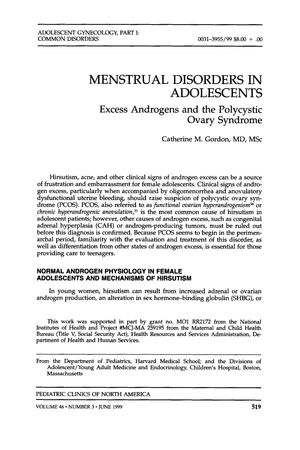Menstrual Disorders in Adolescents
June 1999
in “
Pediatric Clinics of North America
”
polycystic ovary syndrome PCOS insulin resistance cardiovascular disease hirsutism obesity oligomenorrhea anovulation infertility androgen production metabolic issues genetic factors differential diagnosis longitudinal studies androgen levels psychological impacts self-esteem acne carbohydrate metabolism defects therapeutic approaches PCOS insulin resistance heart disease excessive hair growth weight gain irregular periods lack of ovulation difficulty getting pregnant male hormones metabolic problems genetic causes diagnosis long-term studies male hormone levels mental health effects self-confidence skin issues sugar metabolism problems treatments

TLDR The document concludes that early recognition and treatment of PCOS in adolescents is crucial for managing symptoms and long-term health risks.
The document from 1999 examines menstrual disorders in adolescents, with a particular focus on polycystic ovary syndrome (PCOS) and its associated health risks, such as insulin resistance and cardiovascular disease. PCOS, affecting 5% to 10% of premenopausal women, is characterized by a range of symptoms including hirsutism, obesity, oligomenorrhea, anovulation, and infertility. The syndrome is linked to increased androgen production, insulin resistance, and metabolic issues. The document underscores the importance of early recognition of PCOS signs, which often appear during adolescence, and the necessity for healthcare providers to be adept in evaluating and treating this disorder. It also points out the potential genetic factors of PCOS, the need for differential diagnosis, and the significance of longitudinal studies to assess the long-term cardiovascular risks in PCOS patients. Treatment strategies for adolescents include reducing androgen levels, managing insulin resistance, and addressing psychological impacts on self-esteem due to cosmetic issues like hirsutism and acne. The cause of PCOS is still unknown, but ongoing research is expected to shed light on carbohydrate metabolism defects and new therapeutic approaches.



